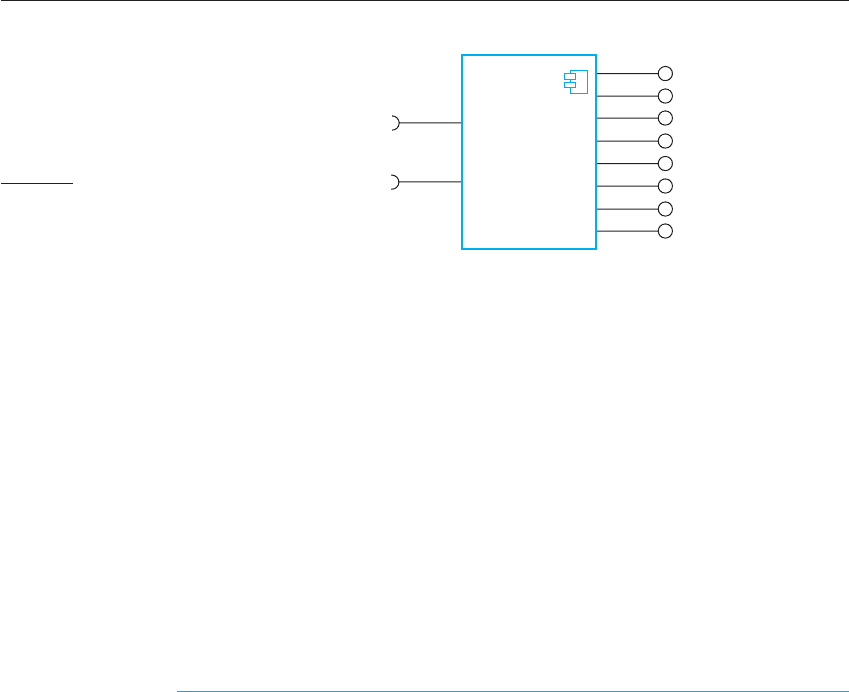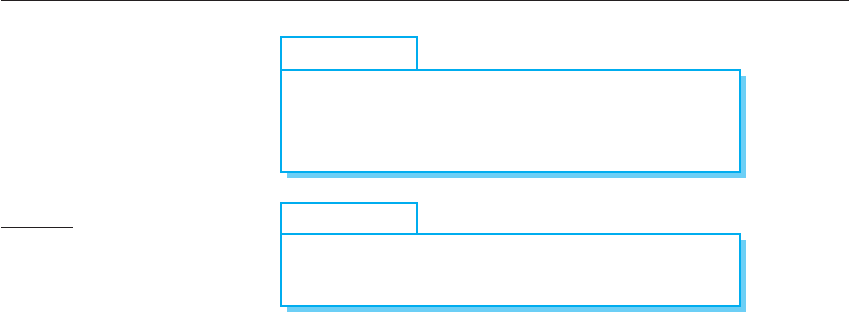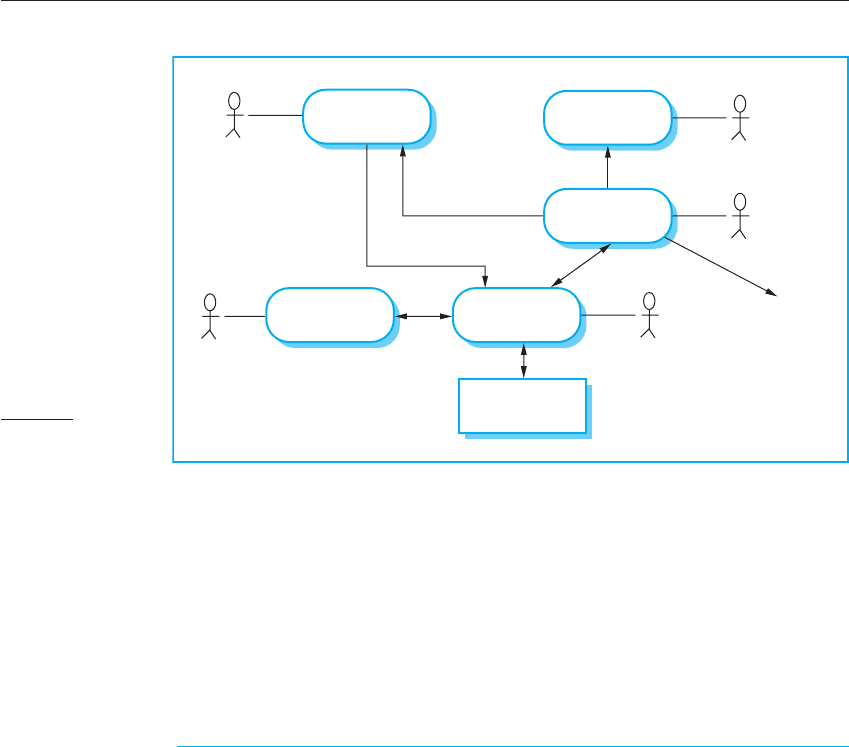Sommerville I. Software Engineering (9th edition)
Подождите немного. Документ загружается.


454 Chapter 17 ■ Component-based software engineering
Problems with CBSE
CBSE is now a mainstream approach to software engineering—it is a good way to build systems. However,
when used as an approach to reuse, problems include component trustworthiness, component certification,
requirements compromises, and predicting the properties of components, especially when they are integrated
with other components.
http://www.SoftwareEngineering-9.com/Web/CBSE/problems.html
on the functionality of available components. I discuss CBSE development
processes in Section 17.2.
Component-based development embodies good software engineering practice. It
makes sense to design a system using components, even if you have to develop rather
than reuse these components. Underlying CBSE are sound design principles that
support the construction of understandable and maintainable software:
1. Components are independent so they do not interfere with each other’s opera-
tion. Implementation details are hidden. The component’s implementation can
be changed without affecting the rest of the system.
2. Components communicate through well-defined interfaces. If these interfaces
are maintained, one component can be replaced by another, which provides
additional or enhanced functionality.
3. Component infrastructures offer a range of standard services that can be used in
application systems. This reduces the amount of new code that has to be developed.
The initial motivation for CBSE was the need to support both reuse and distributed
software engineering. A component was seen as an element of a software system that
could be accessed, using a remote procedure call mechanism, by other components
running on separate computers. Each system that reused a component had to incorpo-
rate its own copy of that component. This idea of a component extended the notion of
distributed objects, as defined in distributed systems models such as the CORBA
specification (Pope, 1997). Several different protocols and standards have been devel-
oped to support this view of a component, such as Sun’s Enterprise Java Beans (EJB),
Microsoft’s COM and .NET, and CORBA’s CCM (Lau and Wang, 2007).
In practice, these multiple standards have hindered the uptake of CBSE. It was
impossible for components developed using different approaches to work together.
Components that are developed for different platforms, such as .NET or J2EE, can-
not interoperate. Furthermore, the standards and protocols proposed were complex
and difficult to understand. This was also a barrier to their adoption.
In response to these problems, the notion of a component as a service was devel-
oped, and standards were proposed to support service-oriented software engineering.

17.1 ■ Components and component models 455
The most significant difference between a component as a service and the original
notion of a component is that services are stand-alone entities that are external to a
program using them. When you build a service-oriented system, you reference the
external service rather than including a copy of that service in your system.
Service-oriented software engineering, which I discuss in Chapter 19, is therefore
a type of component-based software engineering. It uses a simpler notion of a com-
ponent than that originally proposed in CBSE. It has been driven, from the outset, by
standards. In situations where COTS-based reuse is impractical, service-oriented
CBSE is becoming the dominant approach for the development of business systems.
17.1
Components and component models
There is general agreement in the CBSE community that a component is an inde-
pendent software unit that can be composed with other components to create a soft-
ware system. Beyond that, however, people have proposed varying definitions of a
software component. Councill and Heineman (2001) define a component as:
“A software element that conforms to a standard component model and can be
independently deployed and composed without modification according to a
composition standard.”
This definition is essentially based on standards so that a software unit that
conforms to these standards is a component. Szyperski (2002), however, does not
mention standards in his definition of a component but focuses instead on the key
characteristics of components:
“A software component is a unit of composition with contractually-specified
interfaces and explicit context dependencies only. A software component can
be deployed independently and is subject to composition by third parties.”
Both of these definitions are based on the notion of a component as an element
that is included in a system, rather than a service that is referenced by the system.
However, they are also compatible with the idea of a service as a component.
Szyperski also states that a component has no externally observable state. This
means that copies of components are indistinguishable. However, some component
models, such as the Enterprise Java Beans model, allow stateful components, so
these do not correspond with Szyperski’s definition. Although stateless components
are certainly simpler to use, there are some systems where stateful components are
more convenient and reduce system complexity.
What the above definitions have in common is that they agree that components
are independent, and that they are the fundamental unit of composition in a system.
In my view, a better definition of a component can be derived by combining these

456 Chapter 17 ■ Component-based software engineering
Figure 17.1
Component
characteristics
proposals. Figure 17.1 shows what I consider to be the essential characteristics of a
component as used in CBSE.
A useful way of thinking about a component is as a provider of one or more serv-
ices. When a system needs a service, it calls on a component to provide that service
without caring about where that component is executing or the programming lan-
guage used to develop the component. For example, a component in a library system
might provide a search service that allows users to search different library catalogs.
A component that converts from one graphical format to another (e.g., TIFF to
JPEG) provides a data conversion service, etc.
Viewing a component as a service provider emphasizes two critical characteris-
tics of a reusable component:
1. The component is an independent executable entity that is defined by its inter-
faces. You don’t need any knowledge of its source code to use it. It can either be
referenced as an external service or included directly in a program.
2. The services offered by a component are made available through an interface and
all interactions are through that interface. The component interface is expressed
in terms of parameterized operations and its internal state is never exposed.
Component Characteristic Description
Standardized Component standardization means that a component used in a
CBSE process has to conform to a standard component model. This
model may define component interfaces, component metadata,
documentation, composition, and deployment.
Independent A component should be independent—it should be possible to
compose and deploy it without having to use other specific
components. In situations where the component needs externally
provided services, these should be explicitly set out in a ‘requires’
interface specification.
Composable For a component to be composable, all external interactions must
take place through publicly defined interfaces. In addition, it must
provide external access to information about itself, such as its
methods and attributes.
Deployable To be deployable, a component has to be self-contained. It must be
able to operate as a stand-alone entity on a component platform
that provides an implementation of the component model. This
usually means that the component is binary and does not have to
be compiled before it is deployed. If a component is implemented
as a service, it does not have to be deployed by a user of a
component. Rather, it is deployed by the service provider.
Documented Components have to be fully documented so that potential users
can decide whether or not the components meet their needs. The
syntax and, ideally, the semantics of all component interfaces
should be specified.

17.1 ■ Components and component models 457
Requires Interface
Defines the services
that are needed and
should be provided
by other components
Provides Interface
Defines the services
that are provided
by the component
to other components
Component
Figure 17.2
Component
interfaces
Component and objects
Components are often implemented in object-oriented languages and, in some cases, accessing the ‘provides’
interface of a component is done through method calls. However, components and object classes are not the
same thing. Unlike object classes, components are independently deployable, do not define types, are
language-independent, and are based on a standard component model.
http://www.SoftwareEngineering-9.com/Web/CBSE/objects.html
Components have two related interfaces, as shown in Figure 17.2. These inter-
faces reflect the services that the component provides and the services that the com-
ponent requires to operate correctly:
• The ‘provides’ interface defines the services provided by the component. This
interface, essentially, is the component API. It defines the methods that can be
called by a user of the component. In a UML component diagram, the ‘provides’
interface for a component is indicated by a circle at the end of a line from the
component icon.
• The ‘requires’ interface specifies what services must be provided by other compo-
nents in the system if a component is to operate correctly. If these are not available,
then the component will not work. This does not compromise the independence or
deployability of a component because the ‘requires’ interface does not define how
these services should be provided. In the UML, the symbol for a ‘requires’ inter-
face is a semicircle at the end of a line from the component icon. Notice that ‘pro-
vides’ and ‘requires’ interface icons can fit together like a ball and socket.
To illustrate these interfaces, Figure 17.3 shows a model of a component that has
been designed to collect and collate information from an array of sensors. It runs
autonomously to collect data over a period of time and, on request, provides collated
data to a calling component. The ‘provides’ interface includes methods to add,
remove, start, stop, and test sensors. The report method returns the sensor data that
has been collected, and the listAll method provides information about the attached
sensors. Although I have not shown this here, these methods have associated param-
eters specifying the sensor identifiers, locations, and so on.
The ‘requires’ interface is used to connect the component to the sensors. It assumes
that sensors have a data interface, accessed through sensorData, and a management

458 Chapter 17 ■ Component-based software engineering
sensorData
sensorManagement
addSensor
removeSensor
startSensor
stopSensor
testSensor
listAll
report
initialize
Provides InterfaceRequires Interface
Data Collector
Figure 17.3 A model
of a data collector
component
interface, accessed through sensorManagement. This interface has been designed to
connect to different types of sensor so it does not include specific sensor operations
such as Test, provideReading, etc. Instead, the commands used by a specific type of
sensor are embedded in a string, which is a parameter to the operations in the ‘requires’
interface. Adaptor components parse this string and translate the embedded commands
into the specific control interface of each type of sensor. I discuss the use of adaptors
later in this chapter, where I show how the data collector component is linked to a sen-
sor (Figure 17.12).
A critical difference between a component as an external service and a compo-
nent as a program element is that services are completely independent entities. They
do not have a ‘requires’ interface. Different programs can use these services without
the need to implement any additional support required by the service.
17.1.1 Component models
A component model is a definition of standards for component implementation, doc-
umentation, and deployment. These standards are for component developers to
ensure that components can interoperate. They are also for providers of component
execution infrastructures who provide middleware to support component operation.
Many component models have been proposed, but the most important models are
now the WebServices model, Sun’s Enterprise Java Beans (EJB) model, and
Microsoft’s .NET model (Lau and Wang, 2007).
The basic elements of an ideal component model are discussed by Weinreich and
Sametinger (2001). I summarize these model elements in Figure 17.4. This diagram
shows that the elements of a component model define the component interfaces, the
information that you need to use the component in a program, and how a component
should be deployed:
1. Interfaces Components are defined by specifying their interfaces. The compo-
nent model specifies how the interfaces should be defined and the elements, such
as operation names, parameters, and exceptions, which should be included in the
interface definition. The model should also specify the language used to define
the component interfaces. For web services, this is WSDL, which I discuss in

17.1 ■ Components and component models 459
Chapter 19; EJB is Java-specific so Java is used as the interface definition lan-
guage; in .NET, interfaces are defined using the Common Intermediate Language
(CIL). Some component models require specific interfaces that must be defined
by a component. These are used to compose the component with the component
model infrastructure, which provides standardized services such as security and
transaction management.
2. Usage In order for components to be distributed and accessed remotely, they
need to have a unique name or handle associated with them. This has to be glob-
ally unique—for example, in EJB, a hierarchical name is generated with the root
based on an Internet domain name. Services have a unique URI (Uniform
Resource Identifier).
Component meta-data is data about the component itself, such as information
about its interfaces and attributes. The meta-data is important because it allows
users of the component to find out what services are provided and required.
Component model implementations normally include specific ways (such as the
use of a reflection interface in Java) to access this component meta-data.
Components are generic entities and, when deployed, they have to be config-
ured to fit into an application system. For example, you could configure the
Data collector component (Figure 17.2) by defining the maximum number of
sensors in a sensor array. The component model may therefore specify how the
binary components can be customized for a particular deployment environment.
3. Deployment The component model includes a specification of how components
should be packaged for deployment as independent, executable entities.
Because components are independent entities, they have to be packaged with all
supporting software that is not provided by the component infrastructure, or is
not defined in a ‘requires’ interface. Deployment information includes informa-
tion about the contents of a package and its binary organization.
Inevitably, as new requirements emerge, components will have to be changed or
replaced. The component model may therefore include rules governing when
and how component replacement is allowed. Finally, the component model may
Component Model
Usage
Information
Interface
Definition
Specific
Interfaces
Composition
Naming
Convention
Meta-Data
Access
Customization
Packaging
Documentation
Evolution
Support
Interfaces
Deployment
and Use
Figure 17.4 Basic
elements of a
component model

460 Chapter 17 ■ Component-based software engineering
define the component documentation that should be produced. This is used to
find the component and to decide whether it is appropriate.
For components that are implemented as program units rather than external serv-
ices, the component model sets out the services to be provided by the middleware that
supports the executing components. Weinreich and Sametinger (2001) use the anal-
ogy of an operating system to explain component models. An operating system pro-
vides a set of generic services that can be used by applications. A component model
implementation provides comparable shared services for components. Figure 17.5
shows some of the services that may be provided by an implementation of a compo-
nent model.
The services provided by a component model implementation fall into two
categories:
1. Platform services, which enable components to communicate and interoperate
in a distributed environment. These are the fundamental services that must be
available in all component-based systems.
2. Support services, which are common services that are likely to be required by
many different components. For example, many components require authentica-
tion to ensure that the user of component services is authorized. It makes sense
to provide a standard set of middleware services for use by all components. This
reduces the costs of component development and potential component incom-
patibilities can be avoided.
The middleware implements the component services and provides interfaces to
these services. To make use of the services provided by a component model infra-
structure, you can think of the components as being deployed in a ‘container’.
A container is an implementation of the support services plus a definition of the
interfaces that a component must provide to integrate it with the container. Including
the component in the container means that the component can access the support
services and the container can access the component interfaces. When in use, the
component interfaces themselves are not accessed directly by other components;
Platform Services
Support Services
Concurrency
Component
Management
Transaction
Management
Persistence
Security
Resource
Management
Addressing
Interface
Definition
Component
Communications
Exception
Management
Figure 17.5
Middleware services
defined in a component
model

17.2 ■ CBSE processes 461
rather, they are accessed through a container interface that invokes code to access the
interface of the embedded component.
Containers are large and complex and, when you deploy a component in a container,
you get access to all middleware services. However, simple components may not need
all of the facilities offered by the supporting middleware. The approach taken in web
services to common service provision is therefore rather different. For web services,
standards have been defined for common services such as transaction management and
security and these standards have been implemented as program libraries. If you are
implementing a service component, you only use the common services that you need.
17.2
CBSE processes
CBSE processes are software processes that support component-based software engi-
neering. They take into account the possibilities of reuse and the different process
activities involved in developing and using reusable components. Figure 17.6
(Kotonya, 2003) presents an overview of the processes in CBSE. At the highest level,
there are two types of CBSE processes:
1. Development for reuse This process is concerned with developing components
or services that will be reused in other applications. It usually involves general-
izing existing components.
2. Development with reuse This is the process of developing new applications
using existing components and services.
These processes have different objectives and therefore, include different activi-
ties. In the development for reuse process, the objective is to produce one or more
reusable components. You know the components that you will be working with and
you have access to their source code to generalize them. In development with reuse,
you don’t know what components are available, so you need to discover these com-
ponents and design your system to make the most effective use of them. You may not
have access to the component source code.
You can see from Figure 17.6 that the basic processes of CBSE with and for reuse
have supporting processes that are concerned with component acquisition, compo-
nent management, and component certification:
1. Component acquisition is the process of acquiring components for reuse or devel-
opment into a reusable component. It may involve accessing locally developed
components or services or finding these components from an external source.
2. Component management is concerned with managing a company’s reusable
components, ensuring that they are properly cataloged, stored, and made avail-
able for reuse.

462 Chapter 17 ■ Component-based software engineering
3. Component certification is the process of checking a component and certifying
that it meets its specification.
Components maintained by an organization may be stored in a component repos-
itory that includes both the components and information about their use.
17.2.1 CBSE for reuse
CBSE for reuse is the process of developing reusable components and making them
available for reuse through a component management system. The vision of early
supporters of CBSE (Szyperski, 2002) was that a thriving component marketplace
would develop. There would be specialist component providers and component ven-
dors who would organize the sale of components from different developers.
Software developers would buy components to include in a system or pay for serv-
ices as they were used. However, this vision has not been realized. There are rela-
tively few component suppliers and buying components is uncommon. At the time
of writing, the service market is also undeveloped although there are predictions that
it will expand significantly over the next few years.
Consequently, CBSE for reuse is most likely to take place within an organization
that has made a commitment to reuse-driven software engineering. They wish to
exploit the software assets that have been developed in different parts of the com-
pany. However, these internally developed components are not usually reusable
without change. They often include application-specific features and interfaces that
are unlikely to be required in other programs where the component is reused.
CBSE Processes
Specifier,
Designer,
Integrator,
Maintainer
Librarian,
Vendor,
Broker
Librarian
Local or
External
Certifier
External
Source
Domain Analyst,
Designer,
Implementor,
Maintainer,
Market Analyst
CBSE for
Reuse
CBSE with
Reuse
Component
Acquisition
Component
Certification
Component
Repository
Component
Management
Figure 17.6 CBSE
processes

17.2 ■ CBSE processes 463
To make components reusable, you have to adapt and extend the application-
specific components to create more generic and therefore more reusable versions.
Obviously, this adaptation has an associated cost. Thus you have to decide first,
whether a component is likely to be reused and second, whether the cost savings
from future reuse justify the costs of making the component reusable.
To answer the first of these questions, you have to decide whether or not the com-
ponent implements one or more stable domain abstractions. Stable domain abstrac-
tions are fundamental elements of the application domain that change slowly. For
example, in a banking system, domain abstractions might include accounts, account
holders, and statements. In a hospital management system, domain abstractions
might include patients, treatments, and nurses. These domain abstractions are some-
times called ‘business objects’. If the component is an implementation of a com-
monly used domain abstraction or group of related business objects, it can probably
be reused.
To answer the question about the cost effectiveness, you have to assess the costs
of changes that are required to make the component reusable. These costs are the
costs of component documentation, component validation, and making the compo-
nent more generic. Changes that you may make to a component to make it more
reusable include:
• removing application-specific methods;
• changing names to make them more general;
• adding methods to provide more complete functional coverage;
• making exception handling consistent for all methods;
• adding a ‘configuration’ interface to allow the component to be adapted to differ-
ent situations of use;
• integrating required components to increase independence.
The problem of exception handling is a particularly difficult one. Components
should not handle exceptions themselves, because each application will have its own
requirements for exception handling. Rather, the component should define what
exceptions can arise and should publish these as part of the interface. For example, a
simple component implementing a stack data structure should detect and publish
stack overflow and stack underflow exceptions. In practice, however, there are two
problems with this:
1. Publishing all exceptions leads to bloated interfaces that are harder to under-
stand. This may put off potential users of the component.
2. The operation of the component may depend on local exception handling,
and changing this may have serious implications for the functionality of the
component.
